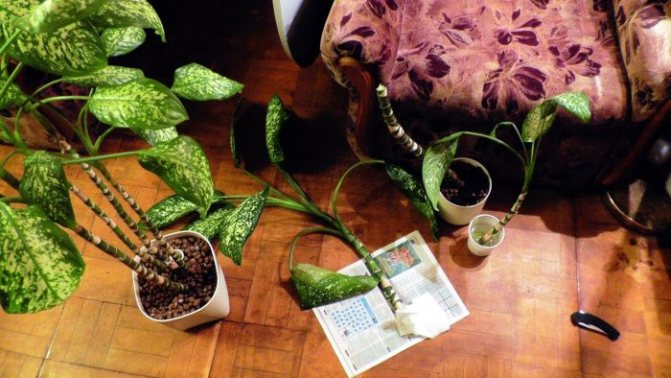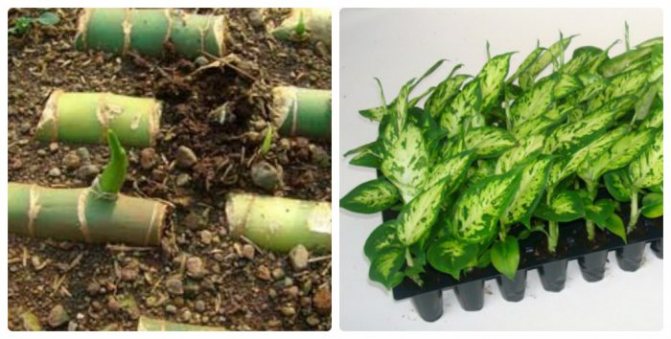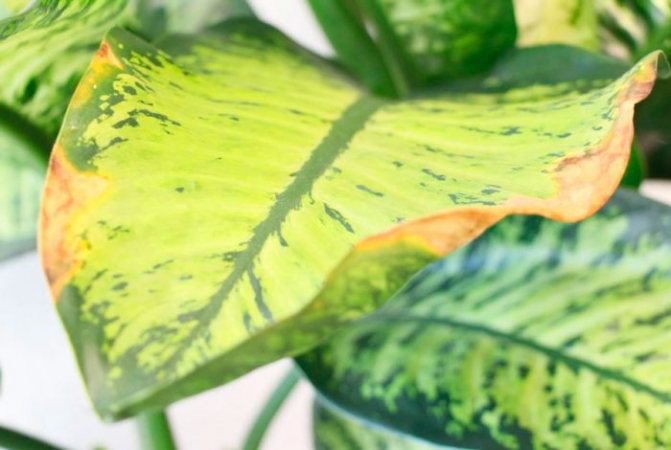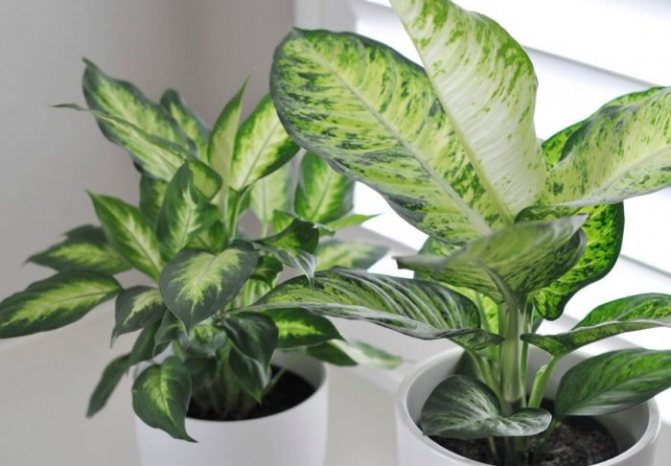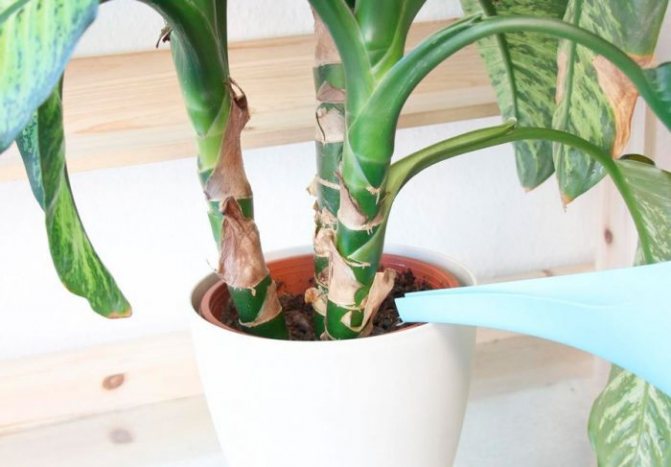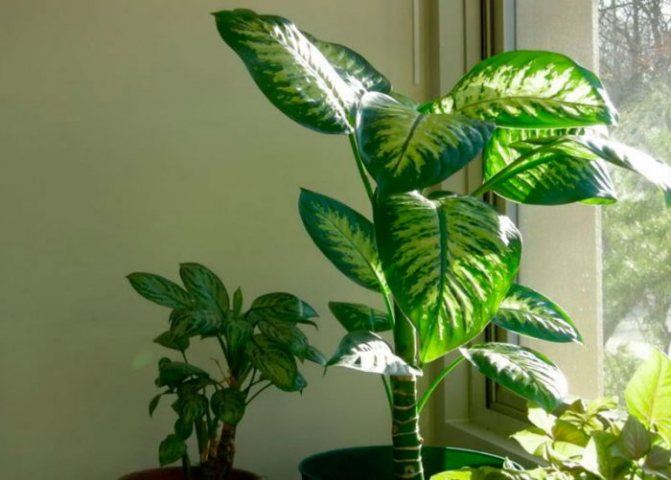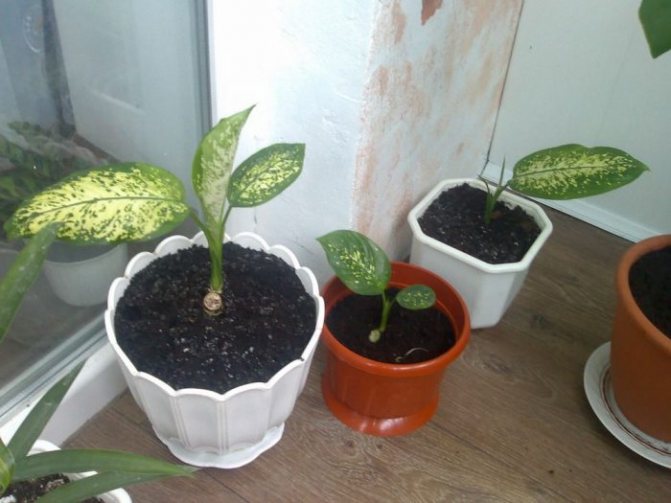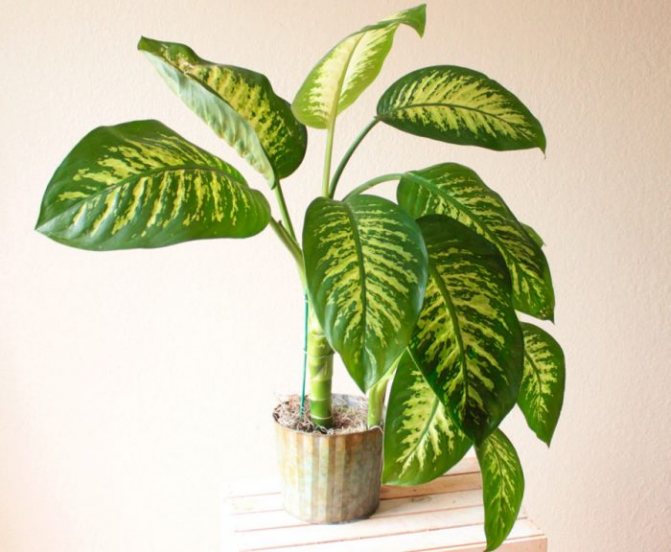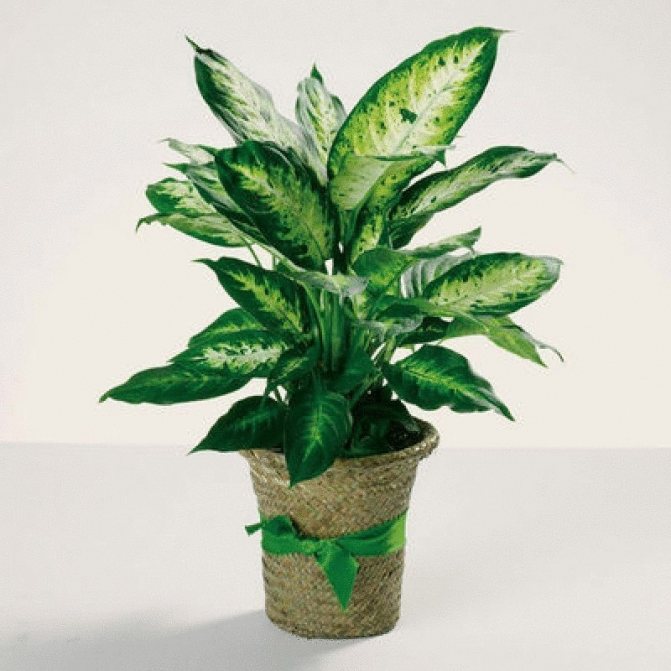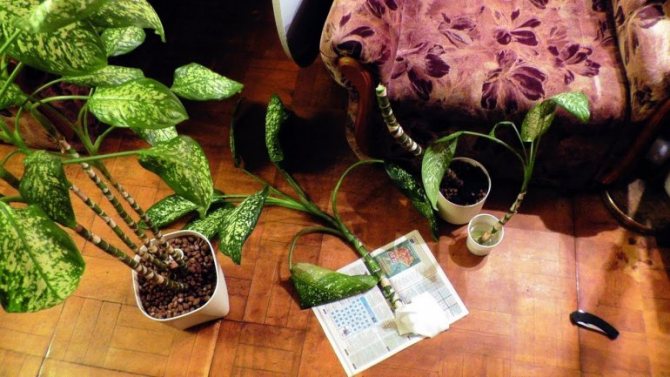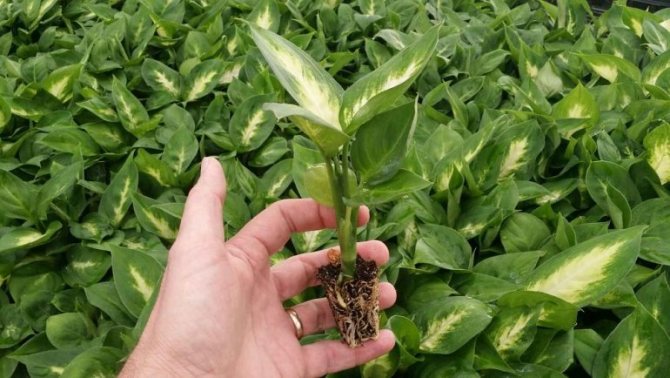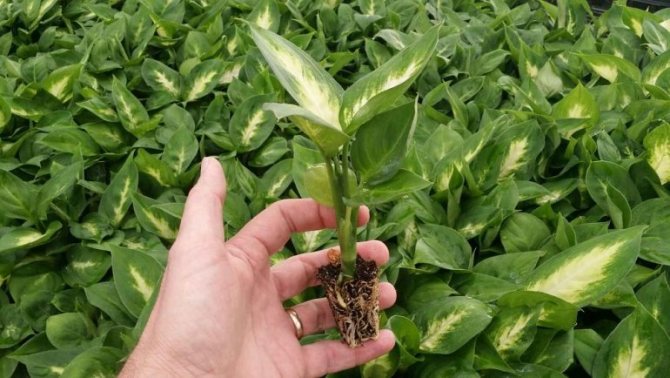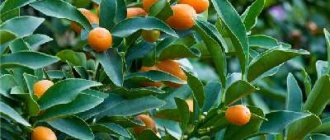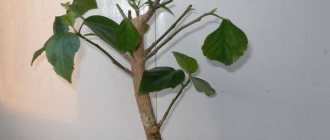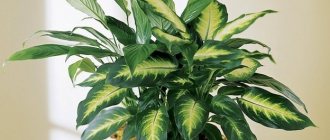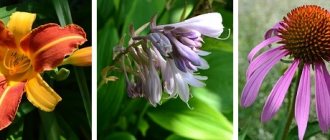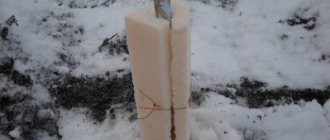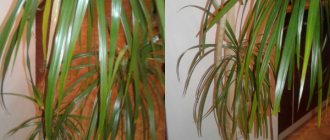Dieffenbachia is an excellent houseplant of the aroid family. Dieffenbachia has beautiful wide leaves with a variegated color. At home, the plant reaches up to 2 meters in height. If you grow dieffenbachia in a room where the air is dry, then it quickly becomes bare and takes on a completely unattractive appearance. In order for the flower to be again both lush and bushy, it is necessary to regularly prune. How to trim dieffenbachia at home is collected in this article.

Pruning time
Dieffenbachia is a flower that stretches upward, but does not bush. To give it the appropriate shape, you need to prune the plant.
The first time you can cut dieffenbachia when it reaches the age of 2-3 years. It is carried out when it is found:
- the stem is bare from below;
- the top shaggy from the excess of leaves;
- falling and yellowing of leaves.
It is advisable to carry out pruning in winter, during a dormant period, although if urgently needed, you can do this at any other time.
In the future, radical pruning is performed every 2-4 years. This allows you to grow several plants from the trimmed part.
Diseases and pests
The plant often encounters pest attacks or the development of diseases. In such a situation, it is recommended to take immediate action.
Spider mite
This is one of the most dangerous pests. It leads to the appearance of a barely noticeable cobweb, wilting and falling leaves. Increased dryness of the air leads to damage to plants. Systematic spraying of the crop will help to avoid problems. Treatment with soapy water or Aktellik will help to cope with pests.
False shield
One can suspect that the culture is damaged by the appearance of brown plaques on the surface of the leaves. Adequate air humidification will help to avoid problems. Insecticides will help to cope with false shield.
Shield
These pests provoke the appearance of sticky spots, drying and leaf fall. To avoid problems, it is worth systematically spraying the plant and wiping it with a damp sponge. A soap solution is used to combat parasites.
Mealy mite
When a plant is infected, its leaves are deformed and dry up, a white bloom appears on their surface. To avoid this, you need to systematically spray the plants. If problems arise, use soapy water and insecticides.
Rot
When the disease appears, there is a risk of wilting and yellowing of the leaves. Often, the disease leads to cracking of the stem. It is impossible to cure it. The top of the plant can be rooted to create a new bush.


Thrips
When the plant is affected by thrips, some parts of the leaves acquire a yellow-white tint and become covered with dark dots. Means such as Tanrek, Fitoverm help to cope with pathology.
Aphid
In this case, the culture is covered with sugary clots, deformation and yellowing of the leaves, and the absence of flowering are observed. It is recommended to treat affected plants with insecticides.
Viral mosaic
This viral infection leads to disruption of development and the appearance of spots on the leaves of the culture. Aktara and Fitoverm help to cope with the pathology.
Pruning Dieffenbachia
An adult plant that is well-rooted is subject to pruning. Before the procedure, you need to prepare:
- a sharp knife with fine teeth and alcohol for processing it;
- cotton pads;
- Activated carbon;
- glass container.
The sequence of actions is as follows:
- a horizontal cut is made with a knife so that small buds in the amount of 2-5 are present on the remaining part;
- alcohol is applied to a cotton pad and the cut site is treated to avoid the appearance of mold and bacteria;
- the stump is covered with a container, it is periodically removed for ventilation.
Since the culture is poisonous, all manipulations are performed strictly with gloves! Wash your hands thoroughly after work!
If desired, a new flower can be grown from the cut part. To do this, it is dried during the day in the open air, then placed in water in which crushed activated carbon is dissolved.
Already after 2 weeks, you can find out how the stalk has started up the first roots. After they appear, you need to root the plant by planting it in a container with soil. This is how pruning flows into the breeding process.
What to do with a cut trunk?
The trimmed remains are used for propagation of dieffenbachia. In this case, not only the top is rooted, but also the long trunk itself:
- Rooting of the apex. Put the cut off crown in a glass of water and wrap it with a dark cloth so that it does not become enlightened. The water is changed every 2-3 days. After the young roots appear, the top is planted in a pot to a cut dieffenbachia or in a separate bowl as an independent plant. You can immediately root it in a mixture of earth and sand.
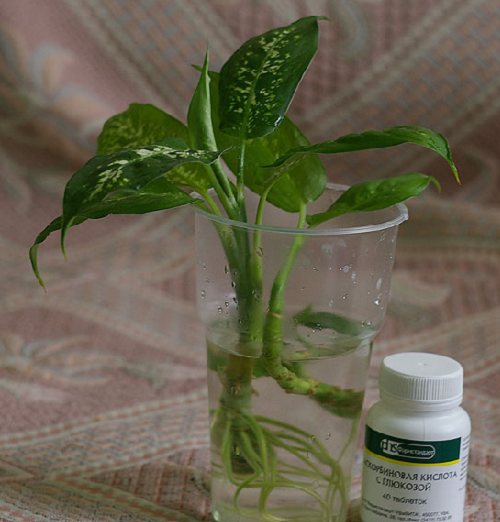

- Rooting the trunk. Cut the long stem into pieces so that buds remain on each. Leave to dry for 2 days at room temperature.
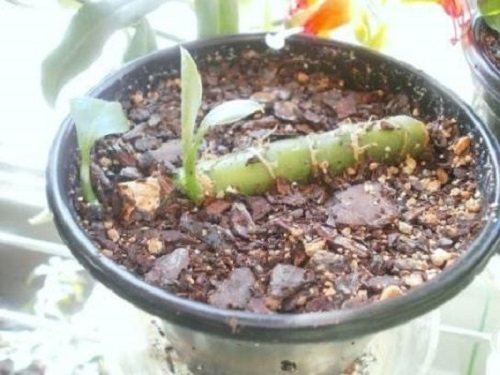

Dieffenbachia rejuvenation by trimming - video
Necessity and timing of transplant
There are several reasons for transplanting a flower:
- the need to improve its appearance;
- the root system is cramped in the pot.
The transplant should be carried out on time, otherwise the flower will begin to ache and shed foliage, and will slow down its growth. Small new foliage is also a signal, as well as the rapid drying of the substrate after watering.
It is advisable to replant the culture in the spring, before the stage of active vegetation. For young plants, the pot is changed annually.
Transfer
Before transplanting a dieffenbachia with a long trunk, you need to prepare a new pot, which should be 2-3 cm larger than the previous one. You will also need new nutritious, loose soil and material for the drainage layer, for example, expanded clay.
The transplant is carried out by the transshipment method. First, you need to carefully remove the plant from the old pot and carefully examine the roots. If necessary, you need to remove:
- affected parts;
- damaged, dry appendages.
Having straightened the roots, remove the adhering earth and treat the sections with a fungicide, crushed activated carbon is also suitable. This will protect the plant from the appearance of infection or viruses.
A drainage layer is poured into a new container, on top - a layer of earth. You can use both a special composition for fruit and deciduous crops, and independently prepared soil. It includes river sand, deciduous soil, moss and peat. The finished mixture should be moderately acidic.
A plant is placed on top of the ground, the free space is filled with the remaining substrate, compacted, watered.
Choosing a new pot and soil
Before preparing dieffenbachia for transplanting, you need to tackle the choice of the optimal soil and capacity.
You need to plant the plant in a pot that is 1–3 cm larger than the previous one. The new container can be taken from the same material as the old pot. Although, if desired, plastic can be replaced with clay, and vice versa.
It is imperative to prepare fresh soil. It is not recommended to buy soil for this flower at a flower shop. The fact is that the purchased land is moisture-consuming. When grown in it, the plant will rot its roots.


You can cook the earth yourself. But for this you need to know the optimal composition of the soil. Dieffenbachia grows well on a mixture of peat, sand and turf. These components are taken in the same proportion. You can add 4 pieces of leafy earth to the soil. Also, the composition of the soil for this flower can be as follows: humus (2 parts), peat (2 parts), leafy earth (2 parts) and sand (1 part). It is recommended to sterilize it before using the soil mixture. It is worth noting that if dieffenbachia is higher than 1 m, then the soil for it should be prepared more difficult. It is recommended here to increase the part of the leafy land. Also, some growers add crushed sphagnum moss, charcoal, garden soil or soil from under coniferous trees to such a soil mixture. Drainage (brick chips, charcoal) is placed in the selected pot, at the bottom of which there must be holes. Only after that, self-prepared soil is poured into the container.
Care
After transplanting and pruning, the flower needs time to recover. At this time, he is provided with high-quality care, which allows the plant to quickly take root and stretch, overgrowing with new foliage.
Lighting and temperature
The culture needs good lighting without direct sunlight. The best option for placing a pot in the house is a place where light partial shade reigns. It can be southwest or southeast.
Indoor air temperature is also an important parameter. It should be around 18-25 degrees Celsius. In such conditions, the flower will quickly regain its strength. In the summer, you can take it out on the balcony or in the garden.
Watering
Dieffenbachia needs regular watering, for this they use warm, settled water. For the period of growth of new branches for several days, you need to abandon this procedure. During the rest period, the frequency of watering is reduced.
It is important to monitor the condition of the soil, avoiding waterlogging. This has a detrimental effect on the state of the flower, it may die.
Air humidity
This parameter is very important for a flower, because it is a tropical culture. It is necessary regularly:
- spray from a spray bottle;
- carry out wet processing of foliage with a soft, damp material, not forgetting about safety measures.
Top dressing
The plant needs good feeding, which is used as:
- organic fertilizers;
- mineral compositions.
Top dressing is carried out immediately after watering twice a month; for the rest period, it is generally abandoned.
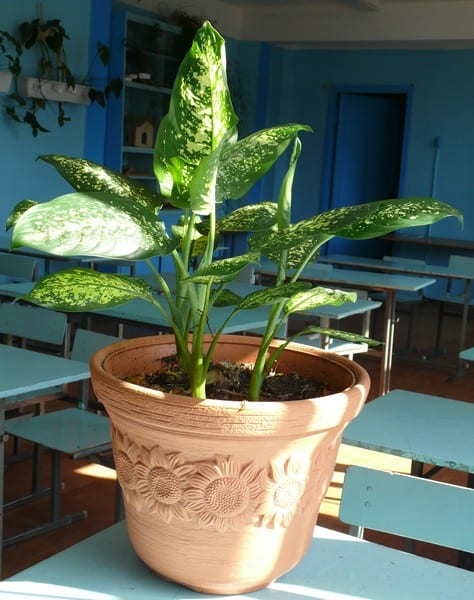

Plant features
This plant belongs to the category of evergreen crops from the Aroid family. In its natural, natural conditions, the flower grows in the tropics of the American continent. The culture got its name in honor of the gardener Joz. Dieffenbach. In natural conditions, there are 40 types of culture. For indoor bush dieffenbachia, rapid growth is characteristic. Some varieties are capable of reaching 2 meters within 5 years.
Brief conclusions
- Dieffenbachia is a tropical flower native to South America. Since it does not bush, but stretches out, it can only be given an appropriate shape by transplanting and pruning. All manipulations must be carried out strictly with gloves, because culture is poisonous!
- Plant pruning is carried out at the age of at least 2-3 years. It is performed if characteristic symptoms are found. If you carry out the procedure on time, you will be able to rejuvenate the bush and save it from developmental problems.
- Transplantation should be carried out on time, otherwise there is a risk of developing diseases, a decrease in the decorative attractiveness of the flower. This is manifested in the fall and decrease of foliage in size, growth retardation, and rapid drying of the soil after it is moistened.
- After all the procedures, the flower needs competent care, it includes regular watering and high-quality feeding.If all the recommendations are followed, the plant will quickly restore strength, begin to grow actively, delighting the eye with lush, variegated foliage.
Dieffenbachia is one of the most common indoor plants, despite the whimsical care. Outwardly, the flower attracts with its rather large variegated leaves and creates a special atmosphere in the interior of your home. The variety of species of this plant makes it possible to choose the appropriate option for decorating the interior space.
If the flower stands in one position for a long time in relation to the sunlight, then it can bend, and the fallen lower leaves will make the plant unattractive. Experienced gardeners know how to prune dieffenbachia and they have the following tips:
Prepare in advance a sharp knife with small teeth (hacksaw), rubber gloves, alcohol, cotton pads, a glass jar with a volume of 0.5 liters, 2-3 tablets of activated carbon.
When pruning dieffenbachia, be extremely careful, since the juice released from the trunk and leaves is quite poisonous. Even after getting 1 drop on the skin or mucous membranes, it can provoke serious health problems. Therefore, you should put on tight gloves before pruning and periodically wipe off the juice that has been released with a clean cloth. Wash your hands thoroughly with an antiseptic when finished. One of the ways to stop the active release of juice is to stop watering the plant 3-5 days before the procedure.
There are no strict time limits for the pruning procedure, that is, it can be done at any time of the year as needed. However, do not forget that radical pruning of the stem dieffenbachia to the base of the root is carried out every 2-4 years, after which several full-fledged plants grow from the trimmed part, creating an excellent decorative effect.
The plant must be mature (trunk diameter at least 2-4 cm) and well-rooted. Be sure to leave small buds on the trunk, from which new shoots will subsequently begin to grow. The optimal number of kidneys is 2 or 5 pieces.
The sequence of actions for cutting is quite simple: make a strictly horizontal cut with a sharp knife, apply alcohol on a cotton pad and wipe the cut part to avoid the spread of harmful molds and bacteria, cover the stump with a jar, which should sometimes be lifted for airing. Remember to regularly water and fertilize the pruned plant as usual.
Dry the removed top of dieffenbachia for a day in the open dry air, and then put it in water for further growth. By adding the crushed activated corner to the water, you will find the first roots in 2 weeks. If the trimmed part is rather large, then it is worth dividing it into several small ones and rooting it in a special soil intended for the flower.
Now you know how to prune Dieffenbachia and these tips will come in handy in the future to properly propagate the flower. The main reasons for the procedure for cutting a flower are considered to be excessive exposure of the trunk, yellowing and falling of leaves, loss of the decorative appearance of the plant. In general, the remaining tops of the plant take root quickly, and a gorgeous flower that looks like a thick bush grows from the cut trunk.
(2
rated, rating:
9,00
out of 10)
Dieffenbachia is one of the most popular indoor plants.
Despite the fact that it comes from South America, it can be successfully grown at home.
In order for the plant to be healthy and could delight for a long time with its attractive appearance, it is necessary to provide it.
How to deal with pests
The effectiveness of treatment is highly dependent on the correct identification of the type of parasite that encroached on the house plant.Diagnosis by symptoms is in most cases successful and, thanks to timely measures, helps to save the plant from death.
Spider mite
The first sign of this pest is spider webs. Its ideal habitat is a warm room with dry air, but an insect can enter the house through an open window if trees grow nearby.
Important: under unfavorable conditions for reproduction, females hide in the ground and hibernate. Achieve a maximum size of 0.5 mm. It is impossible to notice parasites one by one, only in case of mass accumulation.
They are dangerous all year round and prefer to settle on the underside of the leaf. Therefore, the affected plates of dieffenbachia fade, turn yellow and dry out.
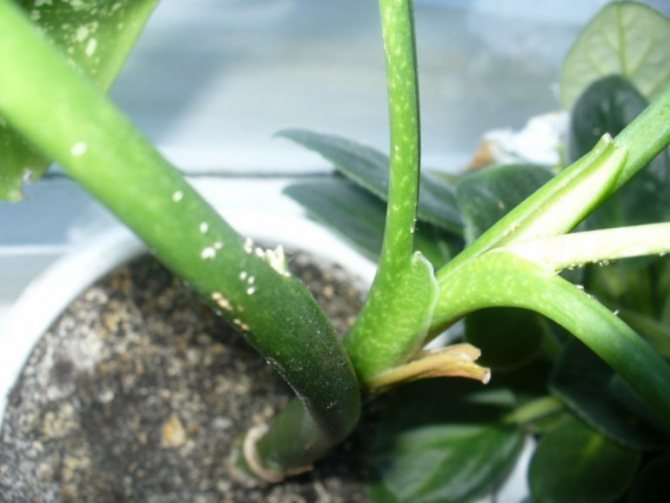

As soon as the first signs of the disease appear, measures must be taken immediately, since the pest multiplies very quickly and affects neighboring flowers.
At the initial stage, it is enough to quarantine the plant, then wipe the leaves and shoots with a sponge dipped in soapy water. To deal with intense damage is effective only with the help of insecticides.
Even with an advanced form of the disease, there are chances to save the plant, but the earlier treatment is started, the more effective the fight will be.
Important: heavily eaten leaves are best cut off. Cutting should be done with protective gloves, as dieffenbachia juice is poisonous and can cause unpleasant irritation on the skin.
Shields and false shields
Yellow dots on green leaves are the first sign of damage. Gradually, they will increase and capture large areas - these are places eaten by insects. As a result, the leaves turn yellow, curl and fall off.
They spread by air currents that allow their light bodies to flutter from one plant to another. Attaching to the sheet, they resemble darker small formations, therefore they are often ignored.


The growth and development of the bush gradually slows down, the leaves fall off, and the flowers die off, sometimes without even opening.
False shields, unlike real ones, do not have a protective shell and it is easier to deal with them, since insecticides act faster and more efficiently.
Remove insects by hand using a soft brush or sponge, wiping the leaf plate, shoots and area around the pot on each side. The tool is moistened in soapy water or a special pest control product. Then they are additionally sprayed with an insecticide.
Aphid
Among the insects dangerous for dieffenbachia, this species causes the most significant damage to the plant. Individuals reach 2 mm in size. The color depends on the subspecies, it can be light green, yellow, red, pink.
They settle in colonies on the youngest leaves and sprouts, feeding on sap. They cause deformation of flowers and plates. They carry dangerous viruses on themselves.
The first sign is the loss of color intensity in the leaves, their curling and dropping, and the presence of sticky marks that are revealed by the excrement of insects.
The plant is treated for aphid infestation by the same measures as for other insects: remove the pests themselves with a sponge dipped in soapy water, treat with an insecticide. For prevention, repeat after 2 days, and then after a week.
Thrips
The appearance and reproduction of these pests, as in the case of the spider mite, is influenced by the temperature contrast. The narrow, elongated body has a brown tint and a pair of wings, and the larvae are yellow.
The affected plant loses its color intensity, acquires brown tones and becomes covered with gray spots. Leaves quickly crumble.
Adults and larvae pose a serious danger to peduncles, which become covered with sticky stains and are deformed.
Gradually, black spots will appear on dieffenbachia, on which a sooty fungus grows very quickly, and this is already dangerous for the life of an indoor flower.
Flycatchers will come in handy for the fight to reduce the population and gain time, as well as an insecticide.
It is interesting: the plant was named after the famous German botanist J. Dieffenbach.
Mealybugs
The oval body of an adult reaches 4 mm and has a pink or orange color, poorly distinguishable due to white bloom. In fact, these are clusters of eggs that live on the parent until a certain period.
Pests live in colonies on the underside of the leaf or on the tops of the shoots, feeding on dieffenbachia juice. The affected plant appears to be covered with snow.
Mealybugs dry out the bush, slowing down and stopping growth. The leaves gradually turn yellow and fall off. A sooty fungus develops on the mucus that remains after insects.
The fight begins with getting rid of eggs and most individuals with a cotton swab or sponge dipped in soapy water. Vodka diluted with water will also help. A heavily affected plant will be saved only by a systemic insecticide.
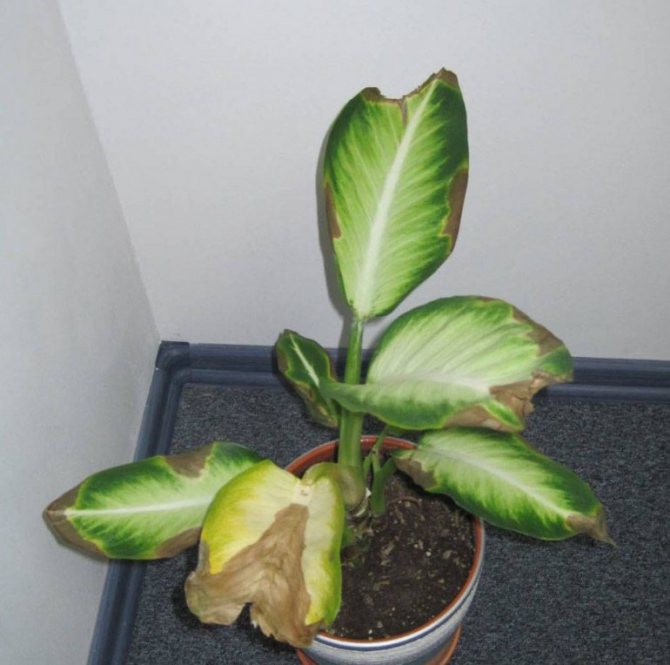

How to trim
Forced cleaning of the crown due to illness or for another reason is always performed in protective gloves - dieffenbachia juice is poisonous and strongly irritates the skin.
Gradually, the lower part of the stem stiffens, fixing itself in a natural way, and the leaves in this zone fall off. Aesthetic appeal is slightly reduced. It happens that under the influence of external factors or having survived a disease, the trunk undergoes changes that negatively affect the entire plant, making it unprepossessing.
To regain beauty, you need to know how to properly trim Dieffenbachia:
- a knife with a fine file is suitable as a tool;
- the cut should be horizontal, not torn.
- the blade is pre-treated with alcohol to avoid infection;
- after the procedure, the instrument must be re-disinfected - the juice is poisonous.


Trimming is carried out only on an adult specimen, the trunk diameter of which is at least 2 cm.
Sequencing:
- Watering is stopped 3-4 days before cutting, so that the plant produces less juice at the cut points.
- The long, bare trunk is removed completely, leaving the stump no more than 10 cm in height. Sleeping buds in the form of half rings will appear on it, shoots will grow from them.
- The juice should be blotted with a dry napkin at the cut points and the wounds should be treated with crushed activated carbon or wood ash.
- Put a jar on the remaining stump, which should be removed after the young shoots appear. Until this moment, raise briefly for airing, so that tissue rotting does not begin.
This same procedure is called rejuvenation and is performed when an adult has to be shortened. In this case, dieffenbachia is cut not under the stump, but at the discretion of the owner. At the site of the division of the main trunk, a large number of new leaves will grow, which will form a kind of crown. The top is rooted separately and planted in the same pot.
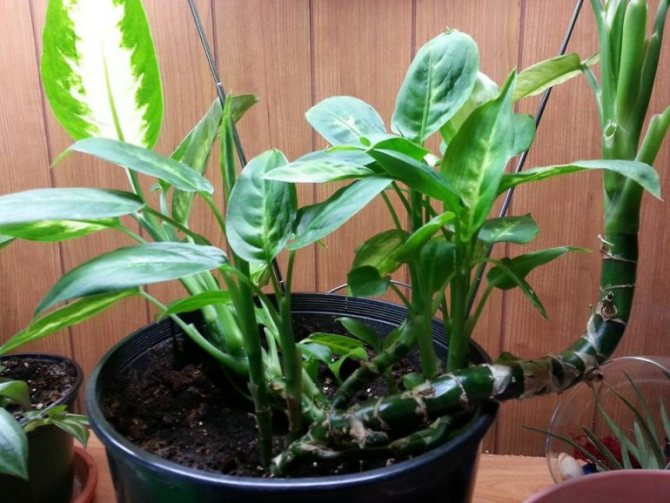

Dieffenbachia transplant at home


It is known that dieffenbachia does not bush on its own, but stretches in height.
To give it the shape of a bush, you have to do pruning and transplanting quite often.
But before transplanting dieffenbachia, you must first understand the reasons why this procedure may be required:
- the owner of the flower just wants to improve its appearance;
- the size of the plant does not correspond to the volume of the pot in which it is located.
If delayed with transplanting, the flower may begin to ache and lose its leaves. Finding out when the time has come for this procedure is very simple. To do this, it is enough to follow the behavior of the plant.
Transplant signals
- Decreased growth rate.
- Fast drying of the soil in the pot after watering.
- Reducing the size of new leaves.
If the plant, the development of which is accompanied by similar symptoms, is removed from the pot, then you can find a root that has grown over the entire space. Before planting, you need to prepare:
- new pot;
- materials for the drainage system;
- water for irrigation.
The pot should be 2-3 cm larger than the old container
.
Before placing a flower in a new place, you should carefully study the state of its root system.
Often, when growing in a confined space, the roots are intertwined, as a result of which some root processes die off.
Therefore, when transplanting a plant, you need to carefully clean the root of adhering soil and remove dead root processes. The trimmed areas must be treated with fungicide and charcoal.
In this way, the root of the plant will be protected from further decay. For transplanting, it is recommended to use neutral soil and new drainage. It is advisable to replant young plants once a year.
Varieties
Today, many types of dieffenbachia are known, which differ in size and appearance.
Variegated
It is one of the more popular varieties and is often grown at home. The bush is large and can reach 2 meters. It is decorated with bright green oval leaves. They are covered with white stripes and spots.
Spotted
This type of dieffenbachia is also widespread. Moreover, this culture is more compact in size - its height does not exceed 1 meter.
The flower is characterized by bright elongated leaves with an asymmetric pattern on the surface.
Leopold
This type of culture is rarely grown. A distinctive characteristic of this dieffenbachia is a very short trunk, which does not exceed 5 centimeters. The plant is decorated with wide leaves of a dark green color. There are white streaks in the center.


Adorable
This is a rather unpretentious plant that easily tolerates moisture deficiency. Therefore, the culture does not suffer in winter during the heating period. To avoid problems, it is important to ensure that the ground does not dry out. The bush reaches 1.5 meters in height. It is decorated with wide leaves of a dark green hue. They are covered with white veins.
Seguina
The plant resembles spotted dieffenbachia. A distinctive feature of this plant is considered to be wider leaves on short petioles. This is a bush flower that is actively used in breeding work.
See also
When is the best time to plant lilies, growing and care in the open field
Oersted
This variety of dieffenbachia is characterized by large green leaves. They are distinguished by a pointed shape and are covered with a noticeable vein. The leaves reach 35 centimeters in length.
Gorgeous
This culture is characterized by variegated leaves. A distinctive feature is considered to be white dots, which are present on the leaves themselves and on the petioles.
Large-leaved
The bushes of this variety reach a height of 1 meter. The plant is characterized by wide ovoid leaves. They have a green tint. In the center there is a thickened vein.
Baumann
This beautiful plant has variegated leaves and is distinguished from other varieties by its very large leaves. In length, they reach 70-80 centimeters. The leaves have a dark green tint and are covered with light specks.


Bause
This variety has excellent decorative properties. The plant is decorated with small leaves, the size of which is no more than 40 centimeters. They are green with a yellow tint. Above are white and dark spots.
Camilla
This plant is considered to be very tall. It is characterized by juicy green leaves with light and dark edging. The plant reaches 2 meters in height and has a powerful stem. It is best to place it in a shaded corner.
Mix Compact
This plant is a compact bush covered with green leaves. They have short petioles and are covered with light spots.
When is the best time to transplant?
Transplanting dieffenbachia at home is carried out in late winter or early spring. Otherwise, the plant may not take root. In the summer, they make a transfer only when absolutely necessary.
Important!
When transplanting a plant, it is undesirable to completely remove the soil from its root.
The flower must be carefully removed from the old pot and placed in a new place. This approach will allow him to quickly and painlessly get used to new conditions.
Fill the free space in a large pot with pre-prepared soil. Be sure to transplant prepare fresh drainage
.
How to transplant long-stem dieffenbachia?
Sometimes it becomes necessary to transplant a plant with a long stem. As a result, its appearance becomes unaesthetic. This problem can be easily solved with circumcision.
When working with the trunk of an adult plant, you will need the following tools and materials:
- latex gloves;
- alcohol;
- warm water or soapy water.
Experts do not recommend cutting off a plant whose trunk has not reached 3-4 cm in diameter. To induce dieffenbachia to bush, the easiest way is to cut off the top. In this case, the dormant lateral buds will revive and the flower will grow in breadth.
The top of the flower can also be planted near the trimmed hemp, resulting in a beautiful and lush bush. Subsequently, the top will take root and can be planted in a separate pot.
Attention!
When circumcising dieffenbachia, a poisonous white liquid is abundantly secreted. Plant sap on the skin can cause severe burns. Therefore, during work it is necessary to protect your hands with gloves.
To reduce the amount of juice produced when the stem is cut, you can stop watering the plant in a few days
before pruning. If the trunk is too strong to cut with a regular knife, you should try using a wood saw.
Before pruning the instrument must be disinfected with alcohol
... At the end of the procedure, the working equipment should be washed to remove the remains of the poisonous juice.
This video shows how to transplant a large dieffenbachia flower into an auto-irrigated pot. In this case, a coconut substrate is used:
It is convenient to combine a flower transplant with its reproduction. in the following ways:
- seed;
- airy cuttings;
- stem cuttings;
During pruning, part of the stem removed is easy to use to plant a new plant. The long, removed stem can be cut into several pieces and deposited in separate containers with prepared soil.
Dieffenbachia: benefits and harms
Dieffenbachia has the following beneficial properties:
- absorbs and neutralizes volatile toxic compounds, improving air quality;
- moisturizes the room;
- protects against insects;
- removes fine dust particles;
- due to the high content of phytoncides, it relieves the room of pathogenic microorganisms, prevents the growth of a large colony of staphylococci.


Is dieffenbachia poisonous
Dieffenbachia is a poisonous plant. Dieffenbachia juice is poisonous. When fiffenbachia juice gets on the skin and mucous membranes, it provokes edema. This is a strong allergen that can lead to skin irritation, itching, and rashes. When ingested, it causes intoxication. The juice is dangerous only if the integrity of the plant integument is violated.
In an adult, toxins are quickly detoxified in liver cells, but while they are in the blood, he may feel nausea, dizziness, and muscle weakness. The child's body cannot cope with such a load, so it may require medical assistance. A similar situation is observed when keeping pets. Small pets may die.
Gloves should be worn when caring for dieffenbachia to avoid contact with plant sap.
Can Dieffenbachia be kept at home?
This decision should be made by the plant owner individually. Plant maintenance is not recommended if there are:
- people with individual intolerance to the components that make up the chemical composition of vegetable juice;
- children under 3-4 years old;
- pets, especially cats.
In other cases, dieffenbachia does not pose a threat to human life. In this case, precautions must be taken to avoid unpleasant consequences in the form of dermatitis or burns.
People who are prone to allergic reactions may develop anaphylactic shock.
Dieffenbachia should not be grown in preschools, health centers, and sleeping quarters. The latter is due to the fact that an evergreen plant begins to produce carbon dioxide at night. This can cause people to experience poor sleep quality. They will begin to feel tired, their performance will decrease.


Safety precautions and assistance for dieffenbachia juice poisoning
During pruning or transplanting, children and animals should not be allowed to approach dieffenbachia. It is necessary to work with shrubs in protective gloves, to protect eyes from getting juice. It is recommended to wear clothing that covers as much of the skin surface as possible.
If the juice gets on the mucous membranes, skin and eyes, you must immediately rinse it off with running water. It is strictly forbidden to swallow the juice from the leaves of the plant. If symptoms of intoxication appear, you need to call an ambulance. As part of first aid, you should:
- give the victim warm water, milk, a weak solution of potassium permanganate;
- monitor the ingestion of an adsorbent (activated carbon), which prevents the absorption of toxins in the small intestine;
- inform the doctors about the time of swallowing the juice, the symptoms manifested.
To reduce the danger to children and animals, it is necessary to place dieffenbachia in a place that is hard to reach.
Rejuvenation of old dieffenbachia: transplant and circumcision
If the plant has taken on an unattractive shape, you can try to rejuvenate it. For transplanting and rejuvenating a flower, you will need the following materials:
- soft soil;
- shredded moss;
- peat mass;
- cleaned sand.
At the beginning of work, carefully cut the stem of the plant 3-5 cm above the flower node. It is better to do this at a right angle so that the stump of the stem is even. The cut is processed using activated carbon. You can use a paper towel to dry it.
The trimmed part of the plant should be covered with a glass jar or piece of cellophane. It will not be superfluous to add a small amount of charcoal to the soil.
For a flower you need to choose slightly acidic soil with the addition of humus
.
If the land was bought in a store, you need to carefully study its composition.
Sometimes, for transplanting a plant, soil collected at the place of growth of conifers is added to the ground.
The flower should be transplanted only into loosened soil. It is advisable to add peat and river sand to the new land.
Caution!
The soil in the pot should never be wet. Otherwise, the roots of the trimmed plant will begin to rot, which will lead to its death.
A prerequisite for transplanting dieffenbachia is soil sterilization.
After planting, the plant needs special care aimed at the earliest possible acclimatization in a new place. During the period until the young leaves have grown, the flower needs to be watered with small portions of purified water.
To speed up the growth of new shoots, you can stop watering for a few days. When new shoots begin to grow actively, you should feed the plant a little. But it is recommended to carry out this procedure in the autumn-winter period no more than once a month, in the summer - once every two weeks.
Breeding video of Dieffenbachia.
For the propagation of dieffenbachia, we need a sharp knife, since it is impossible to leave chipping and burrs on the cut. It must be remembered that Dieffenbachia is a poisonous plant, so you need to work with rubber gloves, especially if there are wounds or cuts on your hands. After finishing work, hands and equipment should be washed with soap and water. The video shows how to make a cut, how to root a cutting, and how to plant it. Happy viewing!
Reproduction of dieffenbachia - video
Good day.
Today we will talk about what to do with Dieffenbachia if it stretched out and bent, because it was not turned to the light in one direction or another, and the lower leaves fell off due to cold drafts or improper watering. In such cases, the best thing that can be done to bring dieffenbachia to a beautiful appearance is to cut it off and root the apex. This is also called apical shoot dieffenbachia propagation.
Now we will just tell you how to properly trim the top of dieffenbachia, and how to root it.
We take a sharp knife and cut it just below the beginning of the bend. As a result, the curved part will be covered with a substrate, and this curvature will in no way affect the decorative effect of the newly transplanted plant.
It is worth remembering that the plant is poisonous, so you need to work with gloves, especially if there are cuts or not completely healed wounds on your hands. After working with the plant, you will need to wash your hands, and before that, try not to get them into your eyes or mouth.
Cut off. Just put the cut off top of Dieffenbachia on a newspaper on the knocks so that the cut point dries up. You can periodically blot the cut with a napkin to remove emerging juice. A day after pruning dieffenbachia, the apical stalk must be placed in water, and after two to three weeks, roots will appear at its base. You can throw an activated carbon tablet into the water. If the cut dieffenbachia has a long piece of the trunk, it can also be cut and rooted - the probability of successful rooting is very high. It .
Dieffenbachia is a tropical perennial ornamental deciduous plant that belongs to the Aroid family. This is an unpretentious plant, caring for dieffenbachia at home will be within the power of even a novice florist. You just need to learn a few simple rules and get acquainted with the features of the flower.
History and description of dieffenbachia
The flower is named after the chief gardener who served at the imperial court in Vienna in the 19th century - Joseph Dieffenbach. He was one of the first to appreciate the decorativeness of this plant and began to use it for landscaping gardens and residences. The main decoration of Dieffenbachia is large oval leaves with a white-green pattern. Bred varieties with one stem and bush. Tall species form a thick juicy trunk up to two meters high.
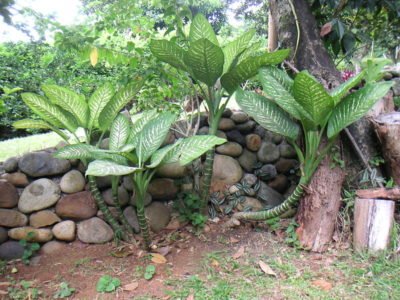

A juicy dieffenbachia trunk is topped with a cap of decorative leaves
In adult dieffenbachia, the stems become bare over time, the leaves remain only on the tops. However, an old flower can be given new life. Surprisingly, cuttings cut from a powerful trunk, several centimeters thick, easily root in ordinary water or wet soil. Dieffenbachia can be cut into its component parts (shoots, cuttings, top, root with hemp), each of which will grow a new plant. The main thing is that there are dormant kidneys on these parts.
Lighting and temperature control
This unusual flower with variegated leaves can be seen in many houses and apartments, where it forms a single composition with orchids, ferns and other flowering crops.
Where to place Dieffenbachia so that it grows healthy and beautiful?
What rules should be followed when growing it? The best place for the plant would be a window with a bright but diffused light so that direct sunlight does not harm its leaves, which can become small and lose their variegated colors. And such a place for a flower is the east, west and north sides of the house.If all windows in your house are southern, then it is better to cover them with curtains. In winter, the flower also tolerates partial shade. If you decide to place it far from the window, you need to provide additional lighting for it.
In spring and summer, the optimal temperature for a flower is 20-22 degrees, but even if it is slightly higher, it will also tolerate heat well, provided that you can maintain high humidity in the room with frequent spraying. In winter, it is better to keep this culture in a cooler room with a temperature of 15-18 degrees. At lower temperatures, it can lose lower leaves. She also does not tolerate sharp drops or increases in temperature.
Dieffenbachia - signs
People who are accustomed to looking for an explanation of their problems and troubles by the standing of the planets, a horoscope and some mystical laws often ask what, in an esoteric sense, the appearance of dieffenbachia in the house threatens. With this question it is better to turn to a fortune-teller, psychic or astrologer, but there are a couple of signs about dieffenbachia that many know about. So, for those who do not know these signs: they say that Dieffenbachia, along with hibiscus, is the strongest "muzhegon". That in families growing this flower in their home, children are not born, because men lose the ability to conceive. And generally they lose the ability to be men.
Using many examples, I could refute these tales, but it is unlikely that people who believe in omens will listen to me. They also say that you cannot keep dieffenbachia in the bedroom, because it absorbs oxygen. To this I can answer that such nonsense is contrary to the law of photosynthesis and common sense. In addition, if you are looking for a bad sign or a bad omen in everything, you are attracting problems, misfortunes and other negativity to yourself. Dieffenbachia is just a beautiful plant, and this is how it should be treated. Pay attention to cats: they are happy to eat dieffenbachia leaves, since for them it is just an anthelmintic.
How to care for dieffenbachia?
Dieffenbachia home care for which consists in optimal conditions of detention, timely watering and feeding, grows very quickly. Every week a new sheet appears on it. For several years, tall plant species grow up to two meters, and small ones - up to a meter. Despite its unpretentiousness, Dieffenbachia does not like drafts and low temperatures, it needs proper watering and pruning.
Watering
How to water dieffenbachia? The soil in the flowerpot where the plant is planted should not dry out and the flower should be watered regularly. Watering dieffenbachia depends on the season:
- in winter it should be moderate and should be done as the soil dries, once every 7 days;
- in spring and summer, the soil in the pot is often watered - once every 2-3 days. Once a week, the culture can have a warm shower.
Before watering, the water must be defended for at least two days. It should not be cold, as this will damage the roots of the plant. If the leaves of the plant turn brown, the water has increased hardness and a little oxalic acid must be added to it. Softer water for irrigation will be rain and snow. It is very important to maintain the balance of water in the soil so as not to cause rotting of the root system. No less important for the bush and moisture. If the air in the room is too dry, the flowerpot is placed in a pallet with wet sand, gravel or moss, or a container of water is placed next to it. Dieffenbachia leaves are wiped with a damp cloth.
Pruning and updating the plant
As it grows, the flower loses its lower leaves and its trunk becomes bare, which means it needs pruning or renewal. How to trim dieffenbachia? Cutting the bare stem of the bush should be carried out with gloves, as the sap of the plant is poisonous and can cause irritation. The stem is cut to a height of 10 centimeters from its base.After a while, new young plants will appear on it.
Young flower care
In the first year of life, it is better to install the bush on the windowsill of the western or eastern window. In order for it to develop correctly and not lose its decorative effect, it is necessary:
- water and spray the flower regularly;
- turn it from time to time so that its trunk is straight and develops evenly from all sides;
- feed with fertilizers containing potassium, reducing the indicated dosage by 50% (before feeding, the flowerpot must be well watered so that the fertilizers do not burn the roots).
Post-pruning maintenance techniques


The flower recovers quickly after pruning. The bare stem begins to overgrow with leaves and grow upward. You can strengthen dieffenbachia with proper care, which consists in watering and feeding:
- Without constant moistening of the soil and air, the plant will die. Water the tree with warm, settled water. And sprayed from a spray bottle, this is especially important when the air in the room is dry. For moistening, you can place damp moss or pebbles in the pan. This will allow the leaves to be saturated with moist vapor constantly. Boggy soil will kill dieffenbachia. Therefore, the need for moisture is determined by the condition of the soil in the pot.
- Plant feeding consists of alternating mineral and organic fertilizers. Exclude organic substances for those species in which light shades prevail in the pattern of the leaf plate. They need non-nitrogen compounds. Fertilizers are applied twice a month. With improper feeding or watering, dieffenbachia sheds foliage, exposing the lower part of the trunk. During the dormant period, the frequency of watering is reduced, and the fertilizing of decorative bushes is stopped.
As soon as the pot becomes small for the plant, it is transplanted into another, larger one. The main method of transplanting is transshipment together with a lump of soil on the roots. It is important to pour a layer of expanded clay into a new spacious pot, and pick up nutritious, loose soil. Indoor plant is unpretentious in care, always pleases with variegated leaves.
More information can be found in the video:
Today I want to introduce you to my tropical beauty - Dieffenbachia, whose homeland is South America. The plant attracts with original colors of lush foliage, unpretentiousness to growing conditions. True, there is one caveat - it does not bush or branch on its own, so there is a need for regular transplanting and pruning. Let's take a closer look at how to properly perform these procedures.
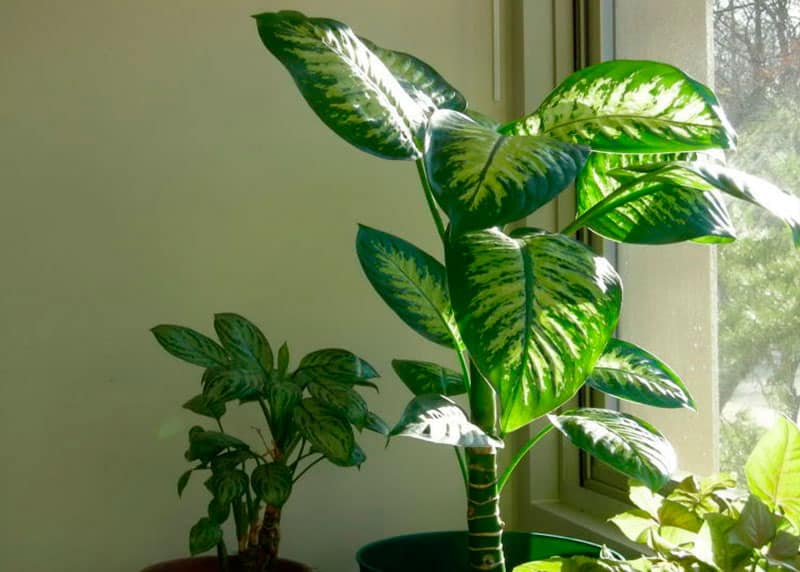

Reproduction methods
You can keep new young plants for yourself if the old bush has lost its decorative effect or make a gift to your friends and family. How does dieffenbachia breed? Dieffenbachia can be propagated at home in several ways: by cuttings, by rooting a piece of the stem, and by the method of forming new shoots on the old trunk. The second method is considered to be quite laborious.
When rooting with the help of pieces of the stem, those on which there are dormant eyes are selected. They are placed horizontally in a container with soil and half deepened. Before planting, the sections of the stem must be treated with charcoal and dried. The first shoots on them may appear not earlier than in 8-12 months.
How to grow a new plant from the leftover old trunk? What to do if you have a small trunk of an adult plant, and the cuttings from it or part of the stem did not work out to root? If dormant buds remain on the trunk, then after a while they may wake up, and you will get a new plant that needs to be carefully cut (when they have the first roots) and transplanted the cut trunk into a new flowerpot.
How to root dieffenbachia if you have pruned it and you have its apical stalk? Propagation of dieffenbachia by cuttings is considered a fairly simple method. They also call it “rejuvenation” of the plant.
The cut off top of the flower is placed in water or potting soil. Add 1-2 tablets of activated carbon to a container with water where the cutting is placed, this will prevent the stem from rotting. Dieffenbachia, which is propagated in this way, gives roots very quickly. It must be planted carefully, since the young roots are very fragile and can be damaged. Self-grown, it will be the pride of every grower, no matter which breeding method you choose!
How to transplant dieffenbachia?
How to properly transplant dieffenbachia? Dieffenbachia is transplanted every year, adult plants - once every 2-3 years. This should be done in the spring, at the end of April. The soil for the flower should consist of:
- four parts of sod land;
- one part of peat;
- one part of leafy soil;
- one part of the sand.
One of the famous florists, V.V. Vorontsov. recommends this potting mix:
- two parts of sod land;
- one part of peat;
- one part of leafy soil;
- and half of one piece of sand.
How to plant dieffenbachia with the least injury? The plant can be transplanted, but you can also "roll over" by moistening a clod of earth and carefully pulling it out of the old flowerpot, so that the clod does not fall apart and the roots are not exposed. The latter method is considered the most gentle and does not allow the plant to hurt after planting.
Propagation by cuttings and layering
Dieffenbachia propagation is carried out using cuttings. This is the most convenient and reliable way. It is easiest to use it when you need to update an old trunk that is bare from age. In this case, carefully cut off the top and blot the cut with a paper towel. Then, for rooting, the tip is placed in water or wet sand. The stalk must be protected from direct sunlight, constantly sprayed so that it receives enough moisture. The temperature should be high enough.
Reproduction by stem cuttings is also possible. To do this, the bare trunk in the pot must be divided into pieces with a knot in the middle. They should be left for a day to dry. Then put on moistened peat mixed with sand, with the buds pointing up. After that, cover with foil and wait for rooting to be transplanted into ordinary soil. The tree stump can also be used: if it is well watered, it will sprout from the remaining nodes. When a couple of leaves grow on them, the shoots can be cut and replanted to produce rooting.
Reproduction can be done by air layers. This is a bit more time-consuming process, but sometimes it is rational to use it. A small incision is made on the stem, covered with moistened moss and wrapped in foil. It is fixed with tape, thread or electrical tape. After some time, roots will grow under it, then this section of the stem is cut off. The film is carefully removed, and the layers with moss are planted in the soil.
Growing these indoor plants is not easy. Dieffenbachia care includes regular transplanting, pruning and breeding. "Green friends" require increased attention to themselves, adherence to the temperature regime and maintenance of the desired humidity level. But they do an excellent job of purifying the air from a variety of harmful substances: formaldehyde, xylene, benzene and others. They will be most useful in the kitchen. It is there that it is worth highlighting a place for a flowerpot.
Read the article: storing grape cuttings in winter
Diseases and treatments
Failure to follow the rules of caring for the plant, you risk its health, since improper or untimely watering, disturbed temperature and insufficient air humidity, which are so important for dieffenbachia, can cause various diseases and pest damage.
Why do dieffenbachia leaves turn yellow? What can cause such changes and what can be done to save the diseased flower?
The pests of this culture are a soft false shield, a mealybug.
The soft scabbard settles on the upper part of the leaves and stems of the plant. The leaves of the bush begin to curl and fall off, and the appearing companion of the scale insect, the twill fungus, can completely destroy it. To prevent this from happening, when this pest appears, remove it from the leaves with cotton wool dipped in alcohol or soapy water. After processing, the humidity in the room must be increased, and the plant itself must be placed in a dark place. The mealybug, which settles on its leaves, branches and flowers, is also a dangerous pest of a flower. The trunk of the bush, like the leaves, is deformed and then dies. They fight him in the same ways as with a false shield.
If the leaves of dieffenbachia turn yellow, then this may be caused by too low a temperature in the room, or due to an emerging disease - root rot. If yellowness appears at the bottom of the plant, and its lower leaves have withered, then you need to increase the temperature in the room or remove the flowerpot from the draft.
Root rot, which causes yellowing of the leaves underneath, appears due to over-watering of the crop and high acidity of the soil. And if the leaves of your Dieffenbachia become yellowed, and the plant itself has stopped growing, it must be removed from the rest of the plants. If the plant is damaged by stem rot, it can still be saved with rooted upper cuttings. They can be planted in new soil, with the addition of activated carbon, which will prevent them from rotting. If the leaves fall off and their browning or loss of color, first of all, adjust the keeping mode of your green pet.

